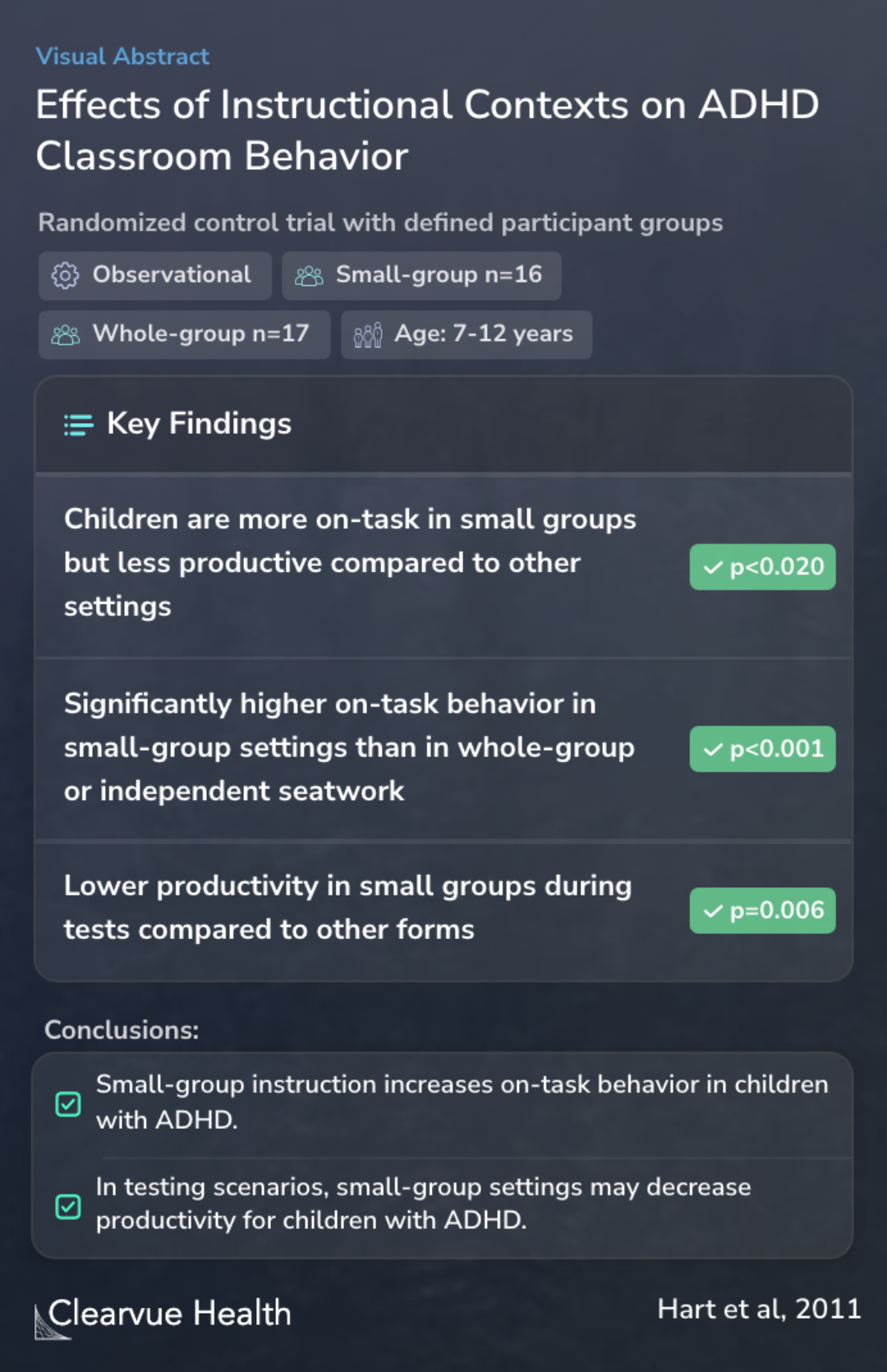Impact of Group Size on Classroom On-Task Behavior and Work Productivity in Children With ADHD
Effects of Instructional Contexts on ADHD Classroom Behavior
Hart, K. C., Massetti, G. M., Fabiano, G. A., Pariseau, M. E., Pelham, W. E.

Objectives
The study aimed to examine how children with ADHD act in different kinds of classroom settings to better understand their academic behaviors.
This study sought to systematically examine the academic behavior of children with ADHD in different instructional contexts in an analogue classroom setting.
Methods
The study involved 33 children with ADHD who were part of a reading activity and a test session. These children were split into different teaching groups: some were taught in small groups, some in large groups, and some worked alone. The purpose was to see how these settings affected their ability to stay focused during lessons and tests and how well they did on the tasks.
A total of 33 children with ADHD participated in a reading comprehension activity followed by a testing period and were randomly assigned within days to either small-group instruction, whole-group instruction, or independent seatwork. The effects of instructional contexts on on-task beha...
Results
The findings showed that children with ADHD were more focused when they were in small groups compared to when they were in large groups or working by themselves. However, even though they were more focused in small groups, they did not do as well in their tests as those in other settings.
Children with ADHD were found to be more on task during small-group instruction than both whole-group and independent seatwork instructional conditions. In the testing context, children with ADHD were found to be less productive in small-group than in the whole-group and independent seat...
Evidence Comparison
The paper's results reveal that specific environments, like small groups, enhance focus for children with ADHD, echoing recognized behavioral therapies that advocate for tailored educational approaches. In line with current guidelines, which emphasize the importance of adaptable educational and behavioral strategies, the study underscores how adjustments in instructional settings can directly impact the effectiveness of ADHD management in school-aged children. These findings align with established practices advocating for controlled and structured learning environments to mitigate ADHD symptoms effectively.
Conclusions
The study shows that working in small groups helps children with ADHD focus better during lessons, but it might make them less productive during tests.
The findings of this study have implications for future research evaluating the standard educational practices and accommodations made for children with ADHD in the classroom setting.
Key Takeaways
More Articles
If you're interested in how social dynamics play into educational strategies for children with ADHD, the findings from a 2013 study by Mikami et al. might catch your attention. This research explored whether a specially designed program could enhance the social inclusion of children with ADHD by their peers. The program led to noticeable improvements: children with ADHD were more liked and had more reciprocal friendships. These outcomes emphasize the value of supportive social environments, aligning with broader educational strategies that aim to create inclusive and engaging classroom experiences.
Another compelling aspect of ADHD management is understanding how different subtypes impact social skills and peer interactions. Research has indicated that various ADHD subtypes distinctly affect children's ability to interact socially. For instance, inattentive ADHD may dampen assertiveness, while combined ADHD can exacerbate impulse control issues in social settings. This differentiation is crucial for tailoring interventions that address specific challenges faced by children with ADHD, further highlighting the importance of personalized treatment plans.